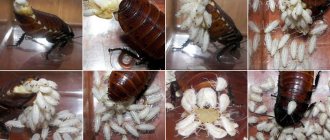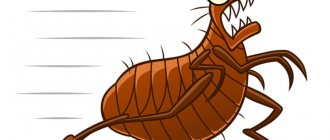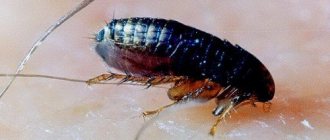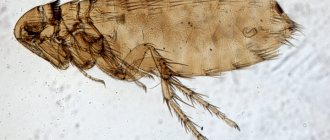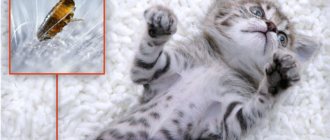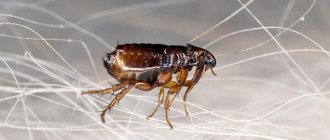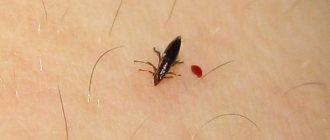Insect Reproduction
Life cycle of flea development
Flea larvae
Methods for destroying eggs and larvae
Control of ectoparasites
Flea eggs are no more than 0.5 mm, the larvae develop unnoticed by humans, adults live in secluded places. You can notice the presence of parasites in your own home or apartment by the bites on your body that appear in the late afternoon. And it is difficult to understand which insect is biting if there is no cat or dog in the house.
Features of the life of parasites
Fleas are unique creatures with a high survival rate. Insects are not picky about environmental conditions, hardy, and jump well in height and length. They live in dark, secluded places.
The optimal condition for existence is a temperature range from 20 to 30 degrees Celsius, humidity – within 60%. In such conditions, the renewal of offspring occurs every 20 days.
Interesting!
An adult can starve for more than 2 months, but in this state does not lay eggs. Flea pupae can easily tolerate temperatures of -10 degrees Celsius. At a temperature of about 28 degrees Celsius, the larvae emerge from the egg after 2 days.
The behavior, feeding habits, and living conditions of larvae and adults differ significantly. They live in different places and have different taste preferences. This situation provides high survival rates for parasites.
What fleas eat depends on the stage of development. For adult individuals, the source of nutrition is animal blood; in special situations, they bite humans. The larvae feed on food waste, rot, particles of epidermis, and feces.
Life cycle of cat fleas
The life cycle of a cat flea lasts 10 days. This is exactly how long it takes for a new adult insect to grow from an egg. A complete change in population composition can occur within one to three weeks.
Life cycle of a flea
The cycle consists of the following stages:
- Egg;
- Larva (3 molts);
- Pupa;
- Adult.
Entomologists call the life cycle of a flea complete. This means that the egg hatches into a larva that differs in appearance from the adult insect. In fleas, there is a complete separation of the habitats of adults and larvae. Flea eggs and their larvae are not located on host animals, but in their environment - litter, grass, burrows.
To prevent them from remaining on a host unsuitable for existence, the female does not lay them, but throws them out of the oviduct under pressure. Thus, it ensures the further life of the larvae on a dead organic substrate.
This method of distribution also ensures that a large number of larvae competing for food do not accumulate in one place, and therefore the survival rate of the offspring increases.
There are from 2 to 5 eggs in one clutch. In total, during her life, if there is a food supply, a female flea can lay up to 500 eggs.
The time it takes for the eggs to hatch into larvae is 2-14 days. In hot weather, fleas reproduce faster and more intensely. The larvae are small whitish-transparent worms that feed on the excrement of adult fleas, as well as dead organic matter - dirt, skin flakes and other organic debris. The low mobility of the larvae is the main reason that they do not leave their hatching site until pupation. Their main habitats are as follows:
- Bedding;
- Gaps in the floor;
- Folds of upholstered furniture;
- Wet dust and dirt under furniture;
- Hay, sawdust, straw and other materials used for winter bedding in enclosures;
- Old clothes and shoes stored in attics and basements.
Any place rich in dead organic matter is ideal for flea larvae. This must be taken into account when developing effective measures to combat these insects.
During their life, the larvae manage to molt three times. They finish feeding and turn into pupae within 10 days. Inside the cocoon of the pupa, an adult flea forms from the larva. The pupal stage has a highly variable duration. Under favorable conditions, the adult insect emerges within a few weeks. Low temperature and humidity can slow down this process to 2-3 months. The pupa is the overwintering stage; in this form, fleas are able to survive the winter. There is evidence that the pupa is able to survive without food for a year, without losing the ability to detect prey and attack it throughout the entire period of starvation.
Life of an adult
Reproduction of insects
Reproduction of fleas occurs at a rapid pace. Sexually mature individuals mate immediately after emerging from the pupa. The very next day the female begins to lay eggs. The trigger mechanism is the animal's blood. If an insect does not receive blood after fertilization, it is not able to reproduce.
How fleas reproduce is hidden from human eyes. The insect lays eggs wherever necessary. There is no special place. Fleas do not build nests.
On a note!
In most cases, mating and laying eggs occurs outside the body of the animal - cat, dog. However, parasites do not live on pets; they are taken only for food. The female literally shoots her eggs. They roll down the wool and fall to the floor.
Fleas reproduce every day. The colony of parasites is replenished at a rapid pace. How many eggs does the female lay? According to various sources, from 5 to 15 eggs at a time.
How do fleas reproduce in cats?
- As a rule, fleas reproduce with the help of larvae, which they lay on the animal's body, in its bedding and in its surrounding areas. Parasites are able to adapt to any danger, so their reproduction does not depend on the conditions in which the pet is located.
- One adult lays about 8 eggs at a time. The insect can live a fairly long life, so during this period the number of eggs can reach as many as 500. This number of larvae is enough for the cat to experience very severe suffering.
- Fleas leave their eggs not only in animal fur or on the carpet. Dust can become a similar object, especially if you do not clean regularly. And also carefully analyze the room for the presence of various holes, you can find a very large number of larvae there.
- Flea larvae look like very small worms that can move very quickly. From birth, they begin to feed on various wastes that remain as a result of the vital activity of adult fleas. With constant nutrition, small individuals begin to grow and molt, which occurs several times in a row. After 3 molts, a fully formed insect appears.
The complete development of a flea to an adult state occurs in approximately 4 weeks. Therefore, those who are interested in the proliferation of fleas in cats should be aware of this in order to prevent colonies of insects from appearing in their home or in the fur of their pet.
The photo shows flea feces.
Development of parasites
Life cycle of flea development
The life cycle of a flea is divided into several stages. An insect with complete metamorphosis.
- Egg. Under favorable conditions, it develops in about 14 days. When the air is very dry and the temperature is above 35 degrees Celsius, the eggs dry out. The same thing happens when you are on a cold surface. The size of one egg is no more than 0.5 mm. They look like a grain of sand. They become noticeable when there is a large accumulation in one place, often under the bedding or rug of animals.
- Larva. The development cycle lasts about 20 days. The rate of conversion also depends on environmental conditions. Under unfavorable conditions it can last up to 1.5 years. With an elevated temperature, she can be born quickly - in 2 days. Flea larvae go through 3 molts. Each time they increase in size. After approximately 18 days it pupates. After 2 days, a new formed flea emerges.
- Imago. Under favorable conditions, an adult lives for 3 months. During this period, 500 individuals of the new generation manage to lay eggs.
Externally, flea larvae differ significantly from adults. An ignorant person, having discovered larvae in his home, cannot understand what kind of parasites they belong to. Photos of parasites are presented below.
Flea development cycle
Insect eggs look like very small grains of rice . And although they are white, it is difficult to notice them even against a dark background without a magnifying glass. In room conditions, eggs mature in about two weeks. If a female lays offspring in the fur of a cat or dog, then the larvae can appear within two days, since the animal’s body is warm and there is food immediately available.
Eggs are very stress-resistant and can easily tolerate high and low temperatures for a short time. Only with prolonged exposure to the sun at high temperatures do they dry out, and in severe frosts do they freeze.
Larva
Under favorable environmental conditions and the presence of a “host” nearby, larvae emerge from the eggs. At birth, they are only about one millimeter long. Their development then goes through three cycles, during which they molt three times .
The larvae feed on dried blood, excrement of adult parasites, pieces of animal skin, and organic debris. Their body is almost transparent, so the esophagus filled with food is visible. When receiving sufficient nutrition, the larva will grow to 6 mm and will wrap itself in a cocoon after about two weeks.
Doll
The time the larva spends in the cocoon directly depends on the temperature and humidity of the air. If the air humidity in the house is about 60% and the temperature is +23–25 degrees , then an adult will appear quite quickly. The minimum development cycle of a pupa is seven days.
If the pupa finds itself in unsuitable conditions, its development into an adult flea can take up to one year. The cocoon evaluates the level of humidity and temperature using its outer cover, on which sensitive receptors are located. The flea in the cocoon also has receptors. With them, the insect can sense the carbon dioxide emanating from a cat or dog, which will be a signal that food is close and it can crawl out.
The fact that parasites are able to survive for a whole year in a cocoon without food is a phenomenon. The remains of the larval shell formed inside the flea are eaten. But it’s definitely not enough for a whole year.
It is also important to know that when fighting parasites in the house, you need to choose a product that would be able to penetrate the defense. Most chemical insecticides do not have such properties. As a result, after disinsection of the house, after some time, new fleas hatch from the cocoon.
Imago
This is the last stage of flea reproduction. If the conditions in the apartment are favorable and the “owner” is nearby, then an adult flea will emerge from the cocoon in at least five days and at most in a few weeks. First of all, the parasite needs to eat, and it will be ready to reproduce.
Having discovered a cat, dog or other warm-blooded animal, the flea jumps to catch up with it , jumps and settles in the fur, where it obtains food for itself.
As a result, we can conclude that fleas reproduce very quickly. They need only nine or ten days in order to go through the development cycle from egg to adult under favorable conditions.
Appearance of the larvae
Flea larvae
What flea larvae look like depends on the stage of development. Initially they are born as white, translucent worms. Length does not exceed 1 mm. Their food consists of feces of adults, skin remains, and rot. They begin to eat actively.
Over time, worms accumulate in places where they can find food:
- dog bedding, cat mats;
- trash bins;
- baskets for storing vegetables, flower pots;
- pet toilet, feeders.
Fighting methods
To kill fleas, folk remedies and professional preparations are used. It all depends on the degree of infection of the room or animal.
Methods for destroying eggs and larvae
Destruction of eggs
To exterminate the flea population, temperature is used. You can kill eggs by freezing them or washing them at high temperatures. Flea eggs are not afraid of the action of insecticides. Pests are destroyed immediately after they are born. Since the larvae do not have time to complete the full development cycle, the parasite population dies.
On a note!
It is necessary to wash your pet's rug at a high temperature, or take it out into the cold, dry it thoroughly, and leave it for two days. You can sprinkle snow on top to increase efficiency.
Fighting larvae
You can get rid of it with powder or dust. In places of detection or probable accumulation, sprinkle paths with boric acid, treat the surface with Mashenka chalk and Clean House dust. The poison enters the body through contact. The destruction of parasites occurs in 10 days. The poison remains active on the surface for about 2 months.
Reproduction
Flea reproduction is a long and difficult process. The female climbs onto the male's back and pulls the male's sex claw into a special spermatheca. This process can take up to 15 minutes, and the mating itself can take about an hour. In the female’s body, from 5 to 15 eggs can mature. If the female is well-fed, then fertilized eggs are laid. Under favorable feeding conditions, the female can carry out several such clutches per day, but more often she is limited to one.
For each mating and laying of fertilized eggs, both the female and the male need nutrients - the blood of the host. Without food, the flea does not reproduce.
Shooting eggs from the abdomen allows them to be distributed over large distances from each other and provide food. Eggs most often end up on the animal’s skin and fur, on the bedding, and in the pet’s favorite habitats. If the food supply is good, then during its life a flea can lay about 500 eggs. This high reproductive capacity makes cat fleas one of the most common and widespread external parasites on pets.

